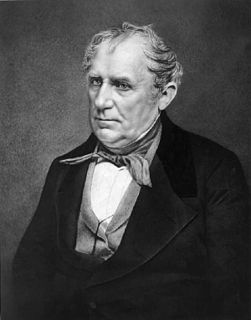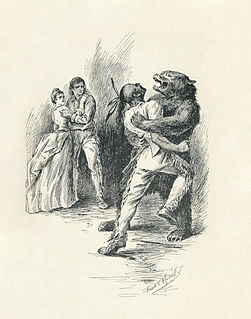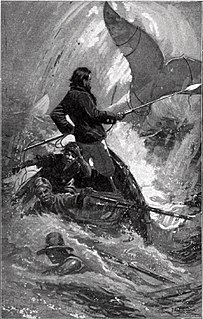Related Research Articles

James Fenimore Cooper was an American writer of the first half of the 19th century, whose historical romances depicting colonist and Indigenous characters from the 17th to the 19th centuries brought him fame and fortune. He lived much of his boyhood and the last fifteen years of life in Cooperstown, New York, which was founded by his father William Cooper on property that he owned. Cooper became a member of the Episcopal Church shortly before his death and contributed generously to it. He attended Yale University for three years, where he was a member of the Linonian Society.

The Last of the Mohicans: A Narrative of 1757 is a historical romance written by James Fenimore Cooper in 1826.

Graham's Magazine was a nineteenth-century periodical based in Philadelphia established by George Rex Graham and published from 1840 to 1858. It was alternatively referred to as Graham's Lady's and Gentleman's Magazine, Graham's Magazine of Literature and Art, Graham's American Monthly Magazine of Literature and Art, and Graham's Illustrated Magazine of Literature, Romance, Art, and Fashion.

George Rex Graham was an American magazine editor and publisher from Philadelphia, Pennsylvania. He founded the journal Graham's Magazine at the age of 27 after buying Burton's Gentleman's Magazine and Atkinson's Casket. His journal became very popular and it was known for its generous payment to contributors.

Precaution (1820) is the first novel by American author James Fenimore Cooper.

The Bravo is a novel by James Fenimore Cooper first published in 1831 in two volumes. Inspired by a trip to Europe where he traveled through much of Italy, the novel is set in Venice. The Bravo is the first of Cooper's three novels to be set in Europe. This group of three novels, which one critic would call Cooper's "European trilogy", include The Heidenmauer and The Headsman. Like his other novels set in Europe, The Bravo was not very well received in the United States. The book largely focuses on political themes, especially the tension between the social elite and other classes.
The Chainbearer; or The Littlepage Manuscripts is a novel by the American novelist James Fenimore Cooper first published in 1845. The Chainbearer is the second book in a trilogy starting with Satanstoe and ending with The Redskins. The novel focuses mainly on issues of land ownership and the displacement of American Indians as the United States moves Westward.

The Heidenmauer; or, The Benedictines – A Story of the Rhine is a novel by James Fenimore Cooper, first published in 1832. The novel is a socio-political novel set in 16th-century Germany that focuses on the competition between various socio-political classes and the tension caused by the Reformation. The Heidenmauer is Cooper's second novel in what one critic would call his European Trilogy, following The Bravo and preceding The Headsman. Like the other novels set in Europe, The Heidenmauer is intent on showing the darker side of European institutions in favor of an American perspective.
Jack Tier, or the Florida Reef is a novel by James Fenimore Cooper first published in 1848 by New York publisher Burgess, Stringer & Co. Set during the Mexican–American War, the novel relates a twenty-year homosocial relationship verging on the homoerotic between a sailor and the captain of the boat. But by the end of the novel the sailor is the captain's wife, transforming the story into one of heterosexual love and passion.

Nautical fiction, frequently also naval fiction, sea fiction, naval adventure fiction or maritime fiction, is a genre of literature with a setting on or near the sea, that focuses on the human relationship to the sea and sea voyages and highlights nautical culture in these environments. The settings of nautical fiction vary greatly, including merchant ships, liners, naval ships, fishing vessels, life boats, etc., along with sea ports and fishing villages. When describing nautical fiction, scholars most frequently refer to novels, novellas, and short stories, sometimes under the name of sea novels or sea stories. These works are sometimes adapted for the theatre, film and television.
Afloat and Ashore is a nautical fiction novel by James Fenimore Cooper first published in 1844. Set in 1796-1804, the novel follows the maritime adventures of Miles Wallingford Jr., the son of wealthy New York landowners who chooses to go to sea after the death of his parents. The novel ends abruptly part way through, and is followed by what critic Harold D. Langely called a "necessary" sequel Miles Wallingford, which resolves many thematic and plot elements. The novel is partially autobiographical, in part by Cooper's own experiences as a sailor, and is his first full-length novel to fully employ a first-person narrative.

Mercedes of Castile; or, The Voyage to Cathay is an 1840 historical novel by James Fenimore Cooper. The novel is set in 15th-century Europe, and follows the preparations and expedition of Christopher Columbus westward to the new world.
The Monikins is an 1835 novel, written by James Fenimore Cooper. The novel, a beast fable, was written between his composition of two of his more famous novels from the Leatherstocking Tales, The Prairie and The Pathfinder. The critic Christina Starobin compares the novel's plot to Jonathan Swift's Gulliver's Travels. The novel is a satire, narrated by the main character, the English Sir John Goldencalf. Goldencalf and the American captain Noah Poke travel on a series of humorous adventures to an Antarctic archipelago inhabited by a race of civilized monkeys.
The Water-Witch is an 1830 novel by James Fenimore Cooper. Set in 17th-century New York and the surrounding sea, the novel depicts the abduction of a woman, Alida de Barbérie, by the pirate captain of the brigantine Water-Witch, and the subsequent pursuit of that elusive ship by her suitor, Captain Ludlow.
Satanstoe is an 1845 novel by the early American novelist James Fenimore Cooper. The novel, sometimes listed with the alternate title The Family of Littlepage or The Littlepage Manuscripts, is the first of a three novel cycle, followed by The Chainbearer and The Redskins. The novel is a fictional autobiography which explores the 18th century colony of New York.
The Two Admirals is an 1842 nautical fiction novel by American author James Fenimore Cooper. The novel was written after the Leatherstocking Tales novel The Deerslayer. Set during the 18th century and exploring the British Royal Navy, Cooper wrote the novel out of encouragement of his English publisher, who recommended writing another sea novel. Cooper had originally intended to write a novel where ships were the main characters, though eventually decided not to. The novels is one of three novels which Cooper would revise for editions following their first printing, the other two being The Pathfinder and Deerslayer.
Wyandotté is a historical novel published by James Fenimore Cooper in 1843. The novel is set in New York state during the American Revolution. The main character of the novel is an Indian, "Saucy Nick", also called Wyandotté, whose depictions violate stereotypes of Native Americans.

The Sea Lions; Or, The Lost Sealers is an 1849 sea novel by James Fenimore Cooper. The plot revolves around two sealers stranded in the Antarctic ice. The novel was first published in two volumes, by Stringer & Townsend. Critic W.B. Gates described the novel as taking inspiration from Charles Wilkes's Narrative of the United States Exploring Expedition of the Years 1838-1842.

"The Lake Gun" is a satirical short story by James Fenimore Cooper first published in 1850. The short story was commissioned by George E. Wood for $100, and published in a miscellany titled The Parthenon. It was reprinted in Specimens of American Literature in New York in 1866. The short story satirizes political demagoguery, focused on William Henry Seward.
The Headsman: The Abbaye des Vignerons is an 1833 novel by James Fenimore Cooper set in Switzerland. The novel was inspired by one of Cooper's trips during his European travels in 1832. The novel is one of three of Cooper's "European" novels, following The Bravo and The Heidenmauer, all of which use the European setting to deal with socio-political contrast with American institutions.
References
- 1 2 3 4 MacDougall, Hugh C. "Transcriber's Preface to Autobiography of a Handkerchief" – via James Fenimore Cooper Society.
- ↑ Axelrad, Allen M. (July 1995). Hugh C. MacDougall (ed.). "Aristocracy forsooth!...the Blackguard is the Aristocrat": James Fenimore Cooper on Congress and Capitalism. 10th Cooper Seminar, James Fenimore Cooper: His Country and His Art. State University of New York College at Oneonta. pp. 7–16.
- 1 2 Bender, Thomas (April 1970). "James Fenimore Cooper and the City". New York History. LI (3): 287–305 – via James Fenimore Cooper Society.